Don't wanna be here? Send us removal request.
Text
A Most Fortuitous Discovery
Scholars have long speculated that a version of the playing cards we know today may have originated in China and travelled Westwards with the Mongol invasions. Along the way it is surmised that such games were adapted to suit the cultures into which they were introduced. It is known that such card games reached Iran, Mamluk Egypt and Syria at the start of the 14th Century. The Venetians, in turn, learned of cards via the saracens and took the games to Europe. Such is the basic history of the transmission of the game to the Western World. During this journey the game of cards took a left turn into India.
Rudolf von Leyden (1908-1983) suggested that the ganjifa cards may have been brought to India by the first Mughals from their ancestral homeland in Inner Asia. When English Ambassador Edward Terry, author of "A Voyage to East-India" visited in the first quarter of the seventeenth century, he saw ganjifa cards often. Modern ganjifa is usually round but rectangular cards were more common during the 18th-century and from records Persian cards were always rectangular. The circular shape of ganjifa was perhaps therefore an Indian innovation.
In December 2018 I chanced upon a small, hand-painted box at a car boot sale in West London and was able to buy it for £4. Measuring 100mm long by 60mm high and 50mm deep I really had no idea what might be inside - I just liked the box. The colourful abstract design within the cross hatching resembles a poppy but might be related to motifs involved in the suits of the contents.

When I later opened the box I found what looked like a long circular tube resembling a thick piece of dowelling covered in fine green powder - mould in fact. On closer inspection I could see that congealed column comprised of a great number of discs that were stuck together. I spent much of that morning gently separating them and cleaning them with soft brushes.
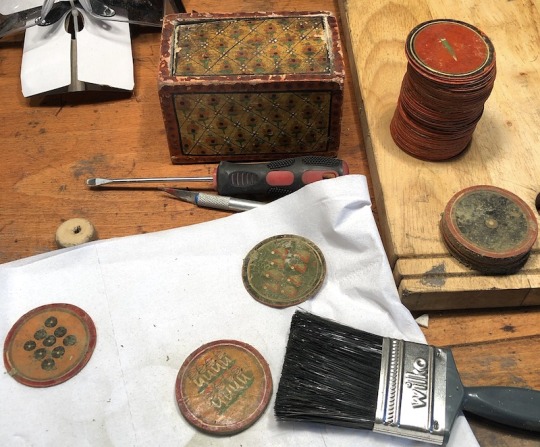
Eventually I was able to establish that what I had were 92 distinct hand-painted discs about 45mm in diameter, plainly painted verso and forming eight families of a dozen. Clearly some sort of game. I had never heard of ganjifa and have little to no knowledge of card games and their variants beyond that gleaned from occasional play. Half an hour of internet research on my phone established that what I had acquired was a near complete and striking example of a Mughal Ganjifa pack in reasonable condition. I was captivated and intrigued.

The cards looked very old and I itched to discover more. Exactly how old were they? Where in India had they been made? What could I find out about this displaced cultural artefact, this strange exotic game, which had found its way into my hand by such serendipitous means
At the same time I began musing on what an incredible survivor any pack of used cards has to be to endure. Think about it: constantly handled, bent, torn, folded, tossed about, rubbed against one another, doubtless used in proximity to food and drink.... Totally ephemeral.
My first strategy was to see if I could find anything similar via Google image searches and hope that more might be known about decks with similar appearances. Might it even be possible to find identical decks by the same hand?
Eventually I found what I was looking for in two separate museums: the first one was displayed on a blog connected to the Ashmolean Museum in Oxford:

Strikingly similar exhibits within the collections identified as Mughal Ganjifa from Rajasthan dating to the 1790s. The second example was in the Fournier de Naipes Museum in Spain where even the box was the same colour and the card themselves, brighter and in better condition could easily have come from the same workshop!
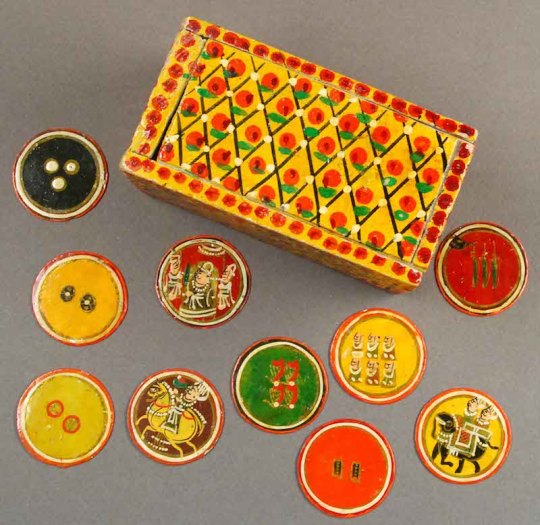

I am not a Spanish speaker so I opted to contact an authority cited on the blog associated with the Ashmolean via email. I won’t name them here as I did not seek any agreement to publish their opinion, but based on the images I provided, it was confirmed that the “set is probably 19th century, and from Rajasthan.” That’s good enough for me. I note also that several auction houses dealing with Eastern art have sold very similar ganjifa sets for four figure sums. But what of my set, what am I to do with it? Perhaps I should continue by describing the game and displaying some more of the cards.
As has been noted above, the set I acquired is sadly four cards short (the phrase not playing with a full deck springs to mind!) It is exceedingly rare to find a full deck for reasons already stated and many individual or small groups of cards appear for sale all the time for surprisingly large sums. Each deck would have originally comprised 96 cards with 8 suits of 12 cards each. Each suit was based on an aspect of life within the Mughal court and there were four ‘strong suits’ and four ‘weak’ suits. The ‘strong’ suits (Bishbar) were Taj (Crowns or flowers), Safed (Silver Coins), Shamsher (Swords) and Ghulam (Servants). The ‘weak’ (Kambar) suits were Chang (Harps), Surkh (Gold Coins), Barat (Bill of Exchange) and Qimash (Packaged Merchandise). These Mughal suits are variously described elsewhere as slightly different things and within other forms of ganjifa the iconography can be completely different. Within each suit we have ‘pip’ cards from 1 to 10 and two ‘court’ cards: a Wazir (or Minister) and finally the Mir (or Shah). The Wazir is depicted as mounted on a horse depending upon the suit, in the Ghulam suit he rides an elephant, in the Surkh a tiger and in the Chang a camel. The Mir is depicted seated on a canopied throne flanked by servants or bodyguards. The obverse of all the cards is the same: a simple red field inscribed with a gold circle.
Here is the Mir of Taj indicated by the red and green ‘flower’ at the ten o’clock position:
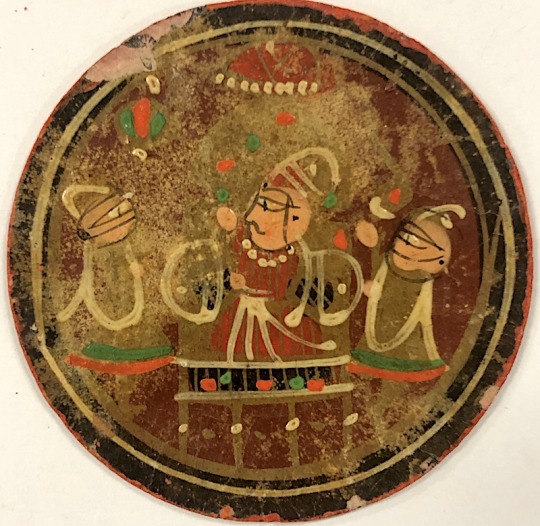
Next we have the Wazir of Taj riding a horse, again with the suit symbol at the ten o’clock position:
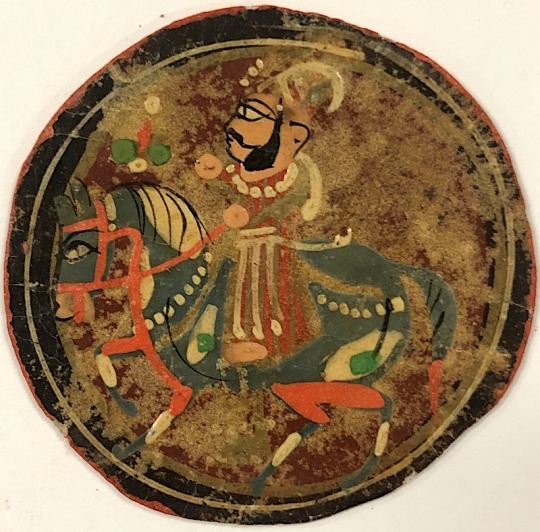
Continuing with the court cards we have the Mir of Safed with the chinha for the suit at the ten o’clock position. Note that the background colours are different to aid player identification:
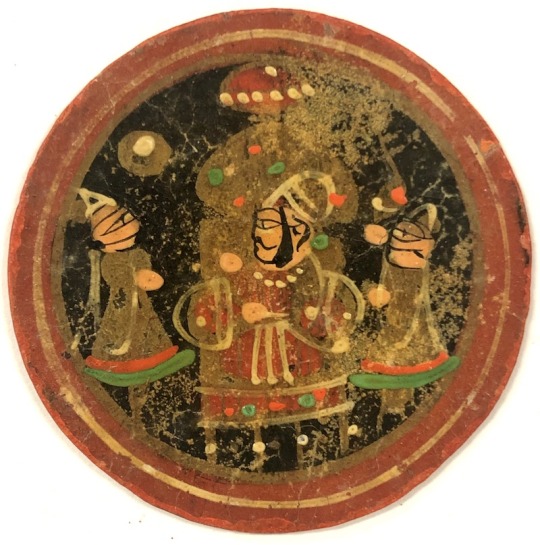
Next we see the Wazir of Safed riding a blue horse with red livery:

13 notes
·
View notes